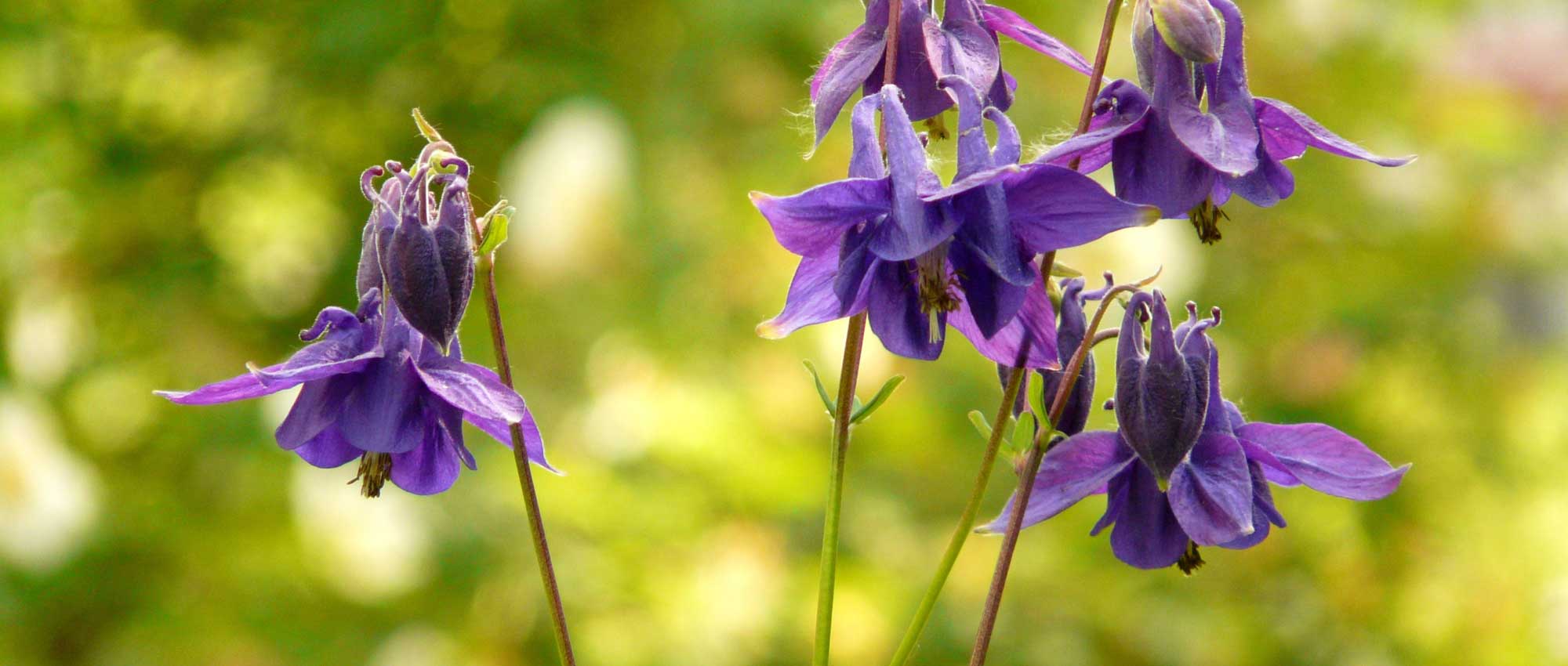
Columbines: sowing, planting and care
Contents
Aquilegias in a nutshell
- Columbines are easy perennials that offer an original and light flowering in spring!
- They come in a wide range of colours: blue, pink, red, yellow, white, purple…
- The flowers can be single or double, solid or bicoloured.
- The foliage, which is finely cut, is decorative.
- Unfussy, columbines adapt to various situations!
- They self-seed and naturalise.
A word from our Expert
Columbines are perennial plants that offer original flowers in a variety of colours. Their flowering, which is very delicate, is characterised by the long spurs that extend the petals. Columbines bloom in spring, in May-June, sometimes until early summer (July-August). They have beautiful finely cut foliage that is very light. The common columbine, Aquilegia vulgaris, which can be found wild in France, bears dark blue flowers, but there are a multitude of varieties that offer a whole palette of colours: pink, white, yellow, red, purple, violet… The flowers are often bicoloured. They also take on different shapes: they can be single or double, sometimes pompom-shaped, or resembling “grandmother’s bonnets”.
The columbine is an easy plant to grow and relatively undemanding… it is perfect for beginners! Don’t be fooled by its apparent fragility: it is a resilient, hardy, robust plant. Planting takes place in autumn or spring, preferably in cool, well-draining soil, although it adapts to many situations. Alpine species will appreciate being grown in rockeries. Columbines can self-seed and naturalise in the garden, but it is also possible to collect the seeds for sowing. Finally, columbines are ideal flowers for making bouquets!
Description and Botany
Botanical data
- Latin name Aquilegia sp.
- Family Ranunculaceae
- Common name Columbine
- Flowering between May and July
- Height often between 40 cm and one metre. Sometimes only 15-20 cm for the smaller species.
- Exposure sun or partial shade
- Soil type humus-bearing, cool and draining
- Hardiness -20 °C
Columbines are perennial plants native to temperate regions of the Northern Hemisphere. They are mainly found in Europe, North America, and Asia, sometimes in mountainous areas. A few species come from Asia, such as Aquilegia flabellata. Some have taken the name of the mountains from which they originate, such as the Alpine Columbine, Aquilegia alpina, or the Pyrenean Columbine, Aquilegia pyrenaica. As for Aquilegia vulgaris, also known as Garden Columbine, it is found throughout mainland France. There are between 70 and 100 species of columbines, to which many horticultural varieties must be added. In nature, they often grow in clear underbrush, at the edge of woods, or in meadows.
Columbines belong to the family Ranunculaceae. This family includes over 2000 species of plants, mostly herbaceous, among which are buttercups, but also aconites, clematis, delphiniums, and hellebores.
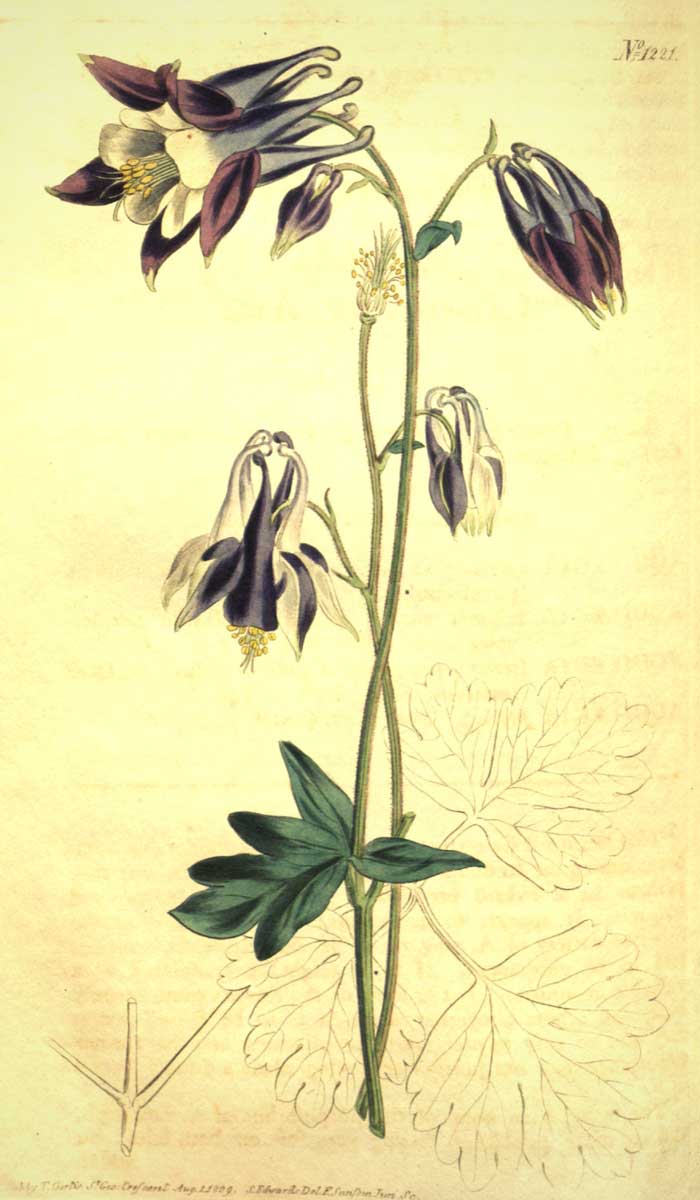
Columbine, Aquilegia – Botanical illustration
There are several possible etymologies for the origin of the name columbine, Aquilegia. One of them is that this word comes from the Latin Aquila = eagle, because the spurs that extend the petals resemble the claws of the eagle. In French, the columbine is known by various vernacular names: Colombine, Gants de Notre-Dame, Aiglantine (reflecting the idea of the eagle)…
Columbines are quite hardy perennials; they are not afraid of the cold. However, they are short-lived plants: they often live between two and four years, sometimes five, rarely more. But they compensate for this flaw by self-seeding abundantly! The different species of columbines easily cross with each other, naturally hybridising.
Columbines form clumps from which upright and branched stems emerge. Most columbines measure between 40 cm and one metre in height. In any case, they rarely exceed one metre tall. Some are much smaller, such as Aquilegia flabellata, which measures between ten and thirty centimetres in height. Similarly, Aquilegia saximontana does not exceed 15 cm.
Columbines usually flower from late spring to early summer, between May and July. Their flowers are borne at the ends of slender stems. They often measure between three and five centimetres long. Those of the Canadian Columbine are particularly small (between 1 and 2 cm in length), while the largest flowers are those of the Mc Kana hybrids, measuring up to 10 centimetres long! Depending on the varieties, columbine flowers are either inclined towards the ground or upright towards the sky. They can be solitary or gathered in clusters often comprising between five and fifteen flowers, sometimes up to twenty.
The flowers can be solid-coloured, but they are often bicoloured, generally with a bright colour on the outside and white in the centre. In any case, the flowers offer a very wide palette of colours: they can be white, red, orange, pink, yellow, light or dark blue, burgundy, violet, purple… sometimes, they are even almost black, as seen in the variety ‘Black Barlow’! As for viridiflora columbine, it has a surprising chocolate and green hue.
Columbines offer an original flowering. The flowers have five truncated petals, extended by long spurs at the back of the flower. These spurs contain nectar, appreciated by insects that come to consume it while ensuring pollination at the same time. The tip of the spur is sometimes curved, ending in a hook. The flowers of the species Aquilegia longissima are impressive due to the length of their spur, making them particularly graceful! The petals are surrounded by five colourful and well-developed sepals, resembling petals (these are also referred to as tepals). It is common for the petals to be white and the sepals to be a bright or dark shade (red, blue, yellow, black…). The flowers then offer a superb contrast! At the centre of the flower, there are numerous yellow stamens.
In general, the flowers are simple, composed of a row of sepals surrounding a row of petals, extended by long spurs. However, hybridisation has given rise to many varieties, sometimes with very different shapes. There are thus varieties with double flowers! They lose their very characteristic shape, resembling more clematis flowers. There are indeed columbines Aquilegia clematiflora, whose name means “clematis-flowered”. Similarly, Barlow columbines (for example, ‘Nora Barlow’ or ‘Black Barlow’) offer double pompom flowers. Sometimes, columbines take the shape of “Grandmother’s Bonnets”, with flowers inclined towards the ground that form a sort of petticoat, with layers of overlapping petals.

Columbine flowers can take different forms: from left to right, the varieties ‘Yellow Queen’, ‘Winky Blue White’ (photo FD Richards), ‘Crimson Star’ and ‘Black Barlow’
Columbines have beautiful finely divided foliage. The leaves are borne on a long petiole that arises from the base, and they are divided into three segments. Each is then further divided into three leaflets, with rounded and dentate or lobed shapes. Like the rest of the plant, the foliage of the columbine has a very fine and light appearance! The few cauline leaves (= placed on the stem) are alternate. The leaves have soft, delicate shapes.
The leaves are green and more or less bluish. Those of the Common Columbine (Aquilegia vulgaris) are glaucous and pubescent on the underside. There are also varieties with variegated foliage, such as ‘Leprechaun Gold’, with green leaves speckled with yellow.
The columbine is a plant with deciduous foliage. It dries up in summer, once the plant has produced seeds, to reappear only in spring.

The foliage of columbines, light and finely divided
The columbine has a long taproot, which is quite fragile, making its transplantation delicate.
The fruits of the columbine consist of five elongated and pointed follicles. These are dry fruits that open at maturity to release numerous oval and black seeds. Don’t hesitate to collect the seeds for later sowing!
Botanical species
This is the Garden Columbine, the most common species. It bears dark blue flowers, with a short and curved spur. It is found wild in France.
- Aquilegia alpina
The Alpine Columbine has violet-blue flowers directed towards the ground. It resembles the Garden Columbine, but its flowers are larger and fewer in number. It is perfect for integrating into a naturalistic garden.
The Canadian Columbine offers small yellow and red flowers, inclined towards the ground and extended at the back by elongated spurs. It is found wild in Canada and the United States.
The Black Columbine bears small dark purple flowers, with long stamens and curved spurs. In the wild, it is mainly found in the Alps.
The main varieties of columbines
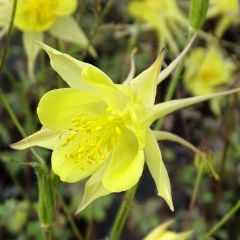
Aquilegia chrysantha Yellow Queen - Columbine
- Flowering time June, July
- Height at maturity 60 cm

Aquilegia flabellata Ministar - Columbine
- Flowering time June, July
- Height at maturity 15 cm
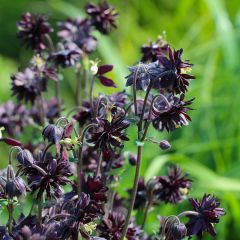
Aquilegia vulgaris var. stellata Black Barlow - Columbine
- Flowering time June to August
- Height at maturity 60 cm

Aquilegia Crimson Star - Columbine
- Flowering time June, July
- Height at maturity 60 cm
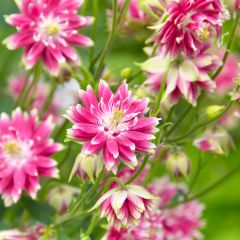
Aquilegia vulgaris Nora Barlow - Columbine
- Flowering time June to August
- Height at maturity 60 cm
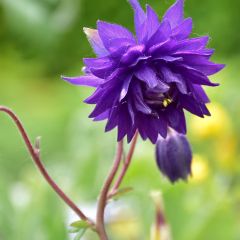
Aquilegia vulgaris Blue Barlow - Columbine
- Flowering time June to August
- Height at maturity 60 cm

Aquilegia vulgaris Munstead White - Columbine
- Flowering time June
- Height at maturity 50 cm
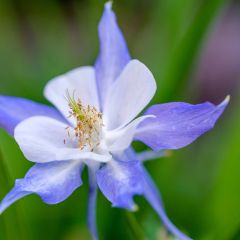
Aquilegia Blue Star - Columbine
- Flowering time May to July
- Height at maturity 60 cm
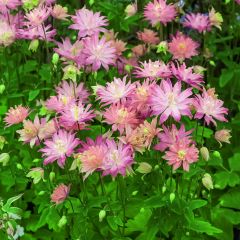
Aquilegia vulgaris Clementine Salmon Rose - Columbine
- Flowering time June, July
- Height at maturity 80 cm
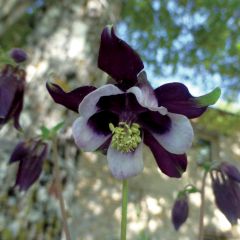
Aquilegia vulgaris William Guiness - Columbine
- Flowering time June, July
- Height at maturity 60 cm
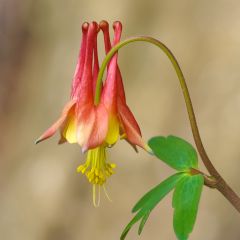
Aquilegia canadensis - Columbine
- Flowering time June, July
- Height at maturity 40 cm

Aquilegia Winky Red-White - Columbine
- Flowering time June, July
- Height at maturity 30 cm
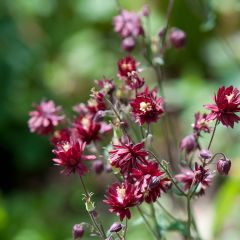
Aquilegia vulgaris Ruby Port - Columbine
- Flowering time June to August
- Height at maturity 70 cm
Discover other Aquilegia
View all →Available in 0 sizes
Available in 0 sizes
Available in 1 sizes
Available in 0 sizes
Available in 2 sizes
Available in 1 sizes
Available in 0 sizes
Available in 1 sizes
Available in 1 sizes
Available in 1 sizes
Planting Aquilegias
Where to plant?
We advise you to choose their location carefully: once well established, columbines do not like to be transplanted! (as they have a rather fragile taproot)
Columbines grow in full sun or partial shade. You can plant them at the base of deciduous trees or in a bright understorey. If you live in the south of France, prefer a slightly shaded position rather than full sun.
Columbines are low-maintenance plants that can grow just about anywhere! However, they prefer rather humus-bearing and light soils, rich in organic matter. We suggest adding some compost at planting time.
Plant your columbines in well-draining but cool soil. They do not like stagnant moisture in winter but will appreciate watering during dry periods, as well as mulching to keep the soil cool. If your soil is heavy, you can plant them on a slope or place gravel in the planting hole to ensure good drainage.
As alpine species enjoy sunny positions and sandy, well-draining soils, they are perfect for rockeries. You can grow species such as Aquilegia saximontana, Aquilegia flabellata or Aquilegia jonesii in this way…
If you do not have a garden, or if you want to enjoy them directly from your home, it is also possible to plant columbines in containers! Choose deep pots, place a layer of drainage at the bottom, then fill with potting soil and plant your columbines.
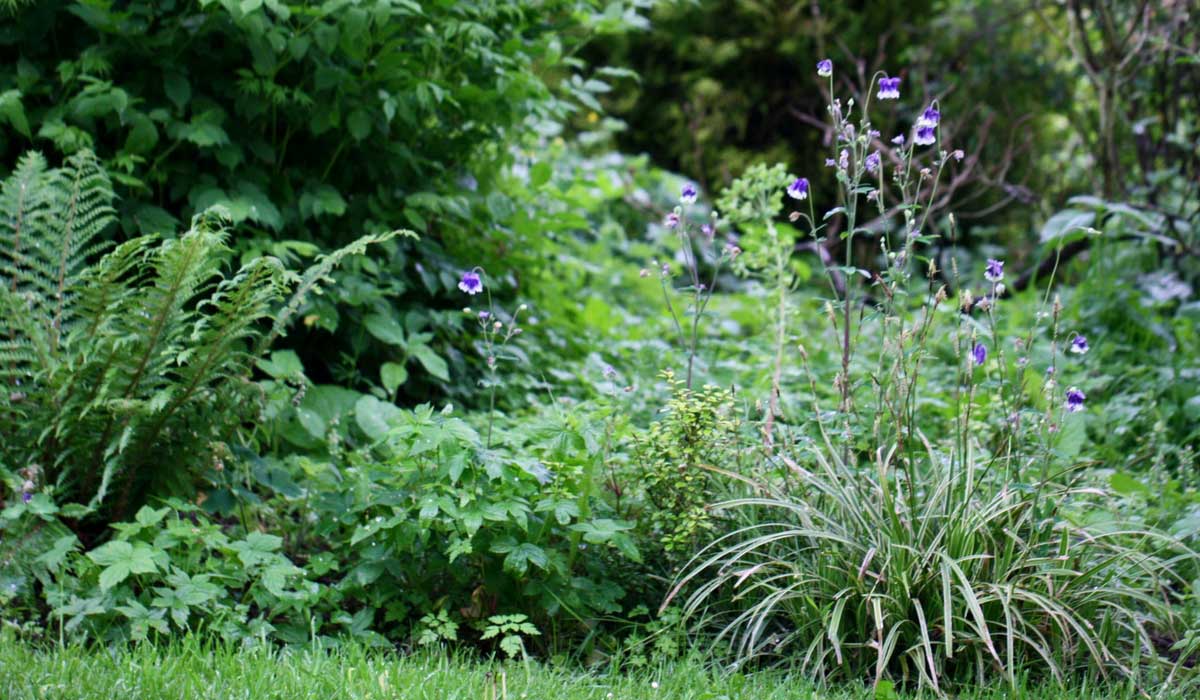
When to plant?
You can plant columbines in autumn, around September, or in spring, in March or April. We recommend planting outside of frost periods.
How to plant?
To allow your columbines to develop well, maintain a distance of at least 30 centimetres between each plant. We also suggest grouping your columbines in groups of at least five plants of the same colour to achieve a more beautiful effect.
- Moisten the root ball by placing it in a basin filled with water.
- If you are planting several columbines, you can lay them on the ground to visualise the effect you want to achieve before planting.
- Dug a planting hole, two to three times the size of the root ball.
- Add some potting soil or well-decomposed compost to enrich the soil. And, if you are growing alpine species, you can add draining materials (pumice, gravel…).
- Place the root ball in the planting hole.
- Replace the soil and firm it down with the palm of your hand.
- Water, then optionally apply mulch.
Discover also our video tips: How to plant perennials?
Care
Aquilegias require very little maintenance. However, we advise watering during the summer and in case of drought. It is preferable to install a mulch at their base to keep the soil cool and to limit weeding! Use ramial chipped wood (RCW) or fallen leaves. Aquilegias will also appreciate a supply of well-decomposed compost in spring.
It is generally advised to cut back faded stems and flowers, as this encourages the appearance of new blooms. But if you leave them in place, there is a chance that your aquilegias will self-seed and naturalise. You can also collect the seeds. However, aquilegias hybridise very easily, and the seedlings often produce flowers different from the original varieties. If you choose to let the aquilegias self-seed, you will likely be surprised to see flowers of different shapes and colours appear!
Aquilegias are very rarely affected by diseases. They may occasionally be affected by powdery mildew, a fungal disease favoured by humidity. If you notice the presence of white, powdery spots, cut off the affected leaves. This disease is not really troublesome, as aquilegias tolerate having their foliage cut back very well. Aquilegia can also be attacked by leaf miners. These are larvae that burrow galleries within the thickness of the leaves. The leaves then bear white, discoloured marks with irregular patterns. Like powdery mildew, leaf miners are not really problematic: you just need to cut and remove the affected leaves. The aquilegia will develop new foliage.
Slugs and snails sometimes nibble on the tender leaves. You can protect your young plants by placing ash or wood chips around them to create a barrier. If this is not enough, consider using slug pellets.
Once flowering is finished, we advise cutting back the foliage. New leaves will appear. Similarly, if your aquilegia is affected by powdery mildew or leaf miners, do not hesitate to cut the leaves.
Propagation: sowing, division
The best technique for multiplying columbines is sowing. It is also possible to divide the clumps, but this technique is a bit more delicate.
Sowing Columbines
Sowing columbine seeds is preferably done in spring. We recommend placing the seeds in the refrigerator for a few weeks beforehand, as they require a cold period to germinate (vernalisation).
You can choose to sow columbine seeds that you have harvested or buy them directly. Discover our range!
You can sow directly in the ground or in pots that you place under a cold frame.
- If you are sowing in place, prepare the soil by refining it and adding potting soil. Otherwise, prepare pots by filling them with substrate. Firm down.
- Sow the seeds, then cover with a thin layer of sifted substrate.
- Lightly firm down.
- Water with a fine spray.
- Transplant when the young plants have reached a size that allows for handling.
If you have sown alpine species, be patient… the seeds can take up to two years to germinate!
Columbines also tend to self-seed spontaneously… And they hybridise very easily, often producing young plants with flowers different from their parents. You can take advantage of this to transplant them elsewhere in your garden.
Dividing Clumps
It is possible to multiply columbines by dividing clumps. This operation is more delicate than sowing, as columbines have a deep and quite fragile taproot, but it allows you to obtain plants that are strictly identical to the original variety. This technique is carried out in autumn.
Identify a sufficiently large clump ready to be divided, and separate a shoot from the original plant by digging deeply. Carefully remove the plant to avoid damaging the roots. Prepare the soil by digging a planting hole and adding some well-decomposed compost. Replant, cover with soil, firm down, and then water generously.
Association
You can combine columbines with other perennials to create a colourful border! Plant them alongside Bleeding Hearts, Delphiniums, Nepetas, or hardy geraniums. Don’t hesitate to add some spring bulbs as well! Some varieties of columbines, particularly those with double flowers, such as ‘Winky Double Red White’ or ‘Ruby Port’, will find their place in a romantic border, alongside roses and clematis!
Because they have a very delicate appearance, with flowers nodding at the end of long floral stems, columbines easily integrate into naturalistic gardens. Prefer varieties with simple, small flowers. The species type, Aquilegia vulgaris, is perfect for this use. Plant them with grasses, alliums, astrantias… And to enhance this very natural look, let the columbines self-seed freely in your garden! Columbines are low-growing perennials that do not smother other plants; when they self-seed, they often settle in unoccupied spaces.
You can incorporate columbines into a woodland garden, planting them alongside ferns, hostas, Bleeding Hearts… Also enjoy the upright, pale green flower spikes of Tellima grandiflora, a perennial with decorative, evergreen foliage that makes a good ground cover in shade!
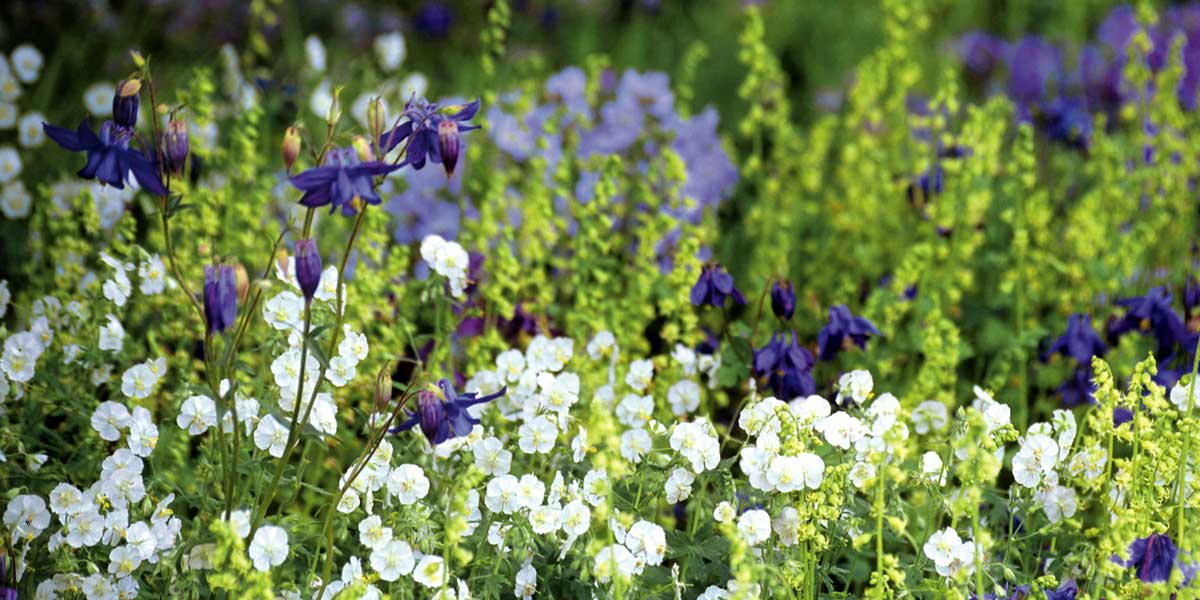
Aquilegia vulgaris, Tellima grandiflora and Geranium phaeum ‘Album’ (GAP Photos – J.S. Sira)
Columbines offer a beautiful diversity of flowering, so take advantage of it to play with colours and create special effects! For example, compose a scene of blue – mauve – white by integrating some columbines alongside delphiniums, clematis, nepeta, roses… You can pair the pure white of columbine ‘Munstead White’ with Amsonia tabernaemontana, a perennial that offers starry blue flowers. Conversely, you can also create a warm-toned scene by pairing columbine ‘Ruby Port’ with bronze fennel.
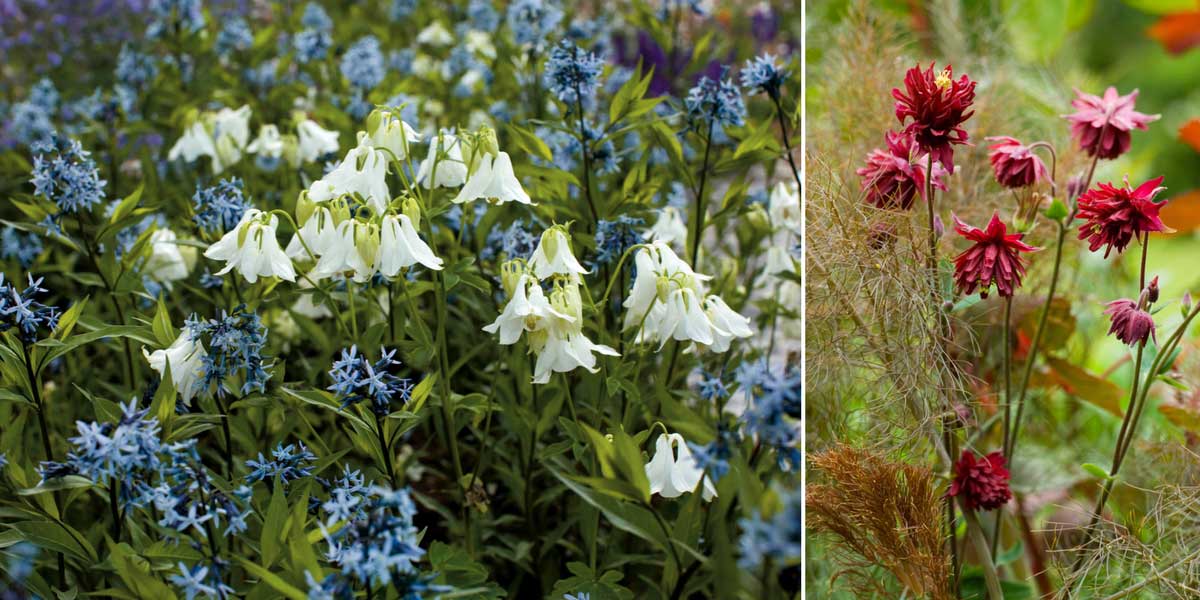
Aquilegia vulgaris ‘Munstead White’ and Amsonia tabernaemontana var. salicifolia (GAP Photos – Pernilla Bergdahl) / Aquilegia ‘Ruby Port’ and Fennel ‘Bronze’ (Photo Jonathan Buckley – Flora Press – Biosphoto)
Finally, alpine species are suitable for planting in rockeries. Combine them with other plants that enjoy sunny, well-drained soils: Stipa tenuissima, aubrietas, phlox, carnations…
→ More association ideas with columbines in our advice sheet.
Did you know?
- A medicinal plant
Garden columbine (Aquilegia vulgaris) has medicinal properties. The root is used externally. It has calming, antiseptic, and diuretic properties, helping to relieve coughs and clean wounds.
Columbine can also be used as a dye plant (for dyeing fabrics).
- Popular beliefs
In the Middle Ages, columbine was attributed with magical and aphrodisiac properties. Its seeds were used to make a perfume that was said to make women irresistible. This belief has earned the plant its common name of Good Woman.
Useful resources
-
- Discover our range of columbines!
- For sowing: our columbine seeds!
- Advice sheet: 5 hardy perennials that are frost-resistant
- Advice sheet: Choosing a columbine
Frequently asked questions
-
The leaves of my columbines have white marks with an irregular pattern. What should I do?
This is the columbine leaf miner: a larva that burrows galleries into the thickness of the leaves. If you notice its presence, don't panic... simply cut the leaves back after flowering. Columbine tolerates having its foliage cut back very well. New healthy leaves will appear.
-
The foliage of my columbines seems to be nibbled.
This concerns snails and slugs, which enjoy the leaves of young plants of columbine, especially when the foliage is still tender. You can place wood chips around your plants to create a barrier. If that is not enough, use slug pellets.
- Subscribe!
- Contents































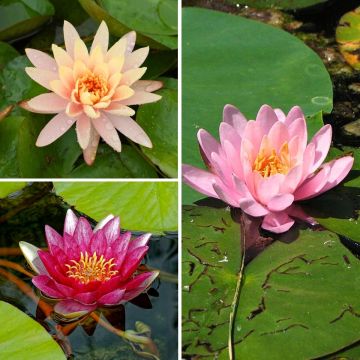

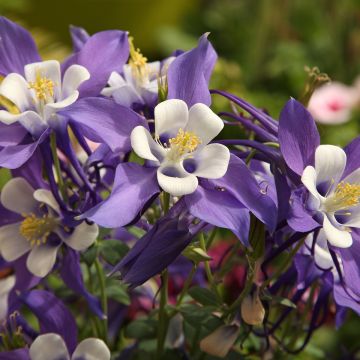
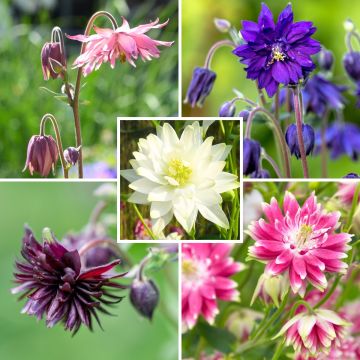

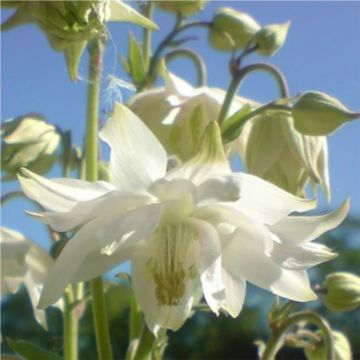
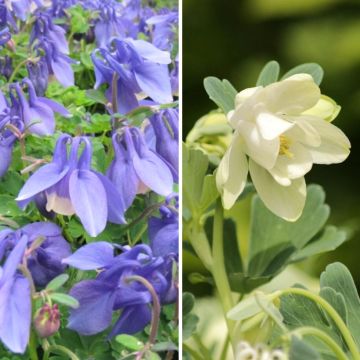


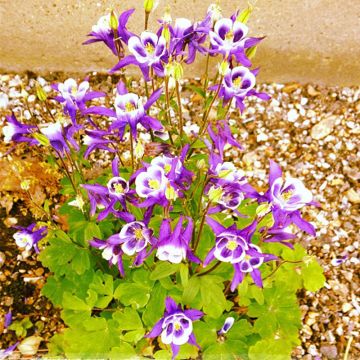
Comments